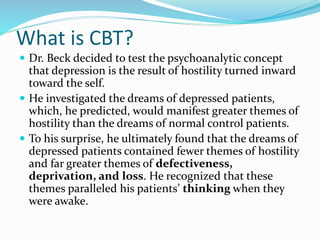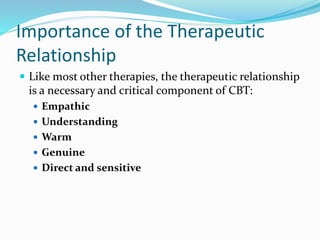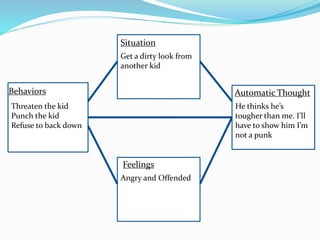This document provides an overview of cognitive behavioral therapy (CBT). It explains that CBT was developed in the 1960s by Aaron Beck and is based on the theory that thoughts, feelings, and behaviors are interconnected, and that by modifying dysfunctional thoughts people can experience improvements in their emotional state and behaviors. The document outlines the basic principles of CBT, including that it is a semi-structured, time-limited, collaborative approach focused on skill development and cognitive change through techniques like identifying and modifying thoughts and beliefs. Research evidence demonstrates CBT is an effective treatment for a wide range of mental health and medical conditions.













![What is the Theory of CBT?
For lasting improvement in patients’ mood and behavior,
cognitive therapists work at a deeper level of cognition: patients’
basic beliefs about themselves, their world, and other
people.
Modification of their underlying dysfunctional beliefs produces
more enduring change. For example, if you continually
underestimate your abilities, you might have an underlying
belief of incompetence.
Modifying this general belief (i.e., seeing yourself in a more
realistic light as having both strengths and weaknesses) can
alter your perception of specific situations that you
encounter daily. You will no longer have as many thoughts with
the theme, “I can’t do anything right.” Instead, in specific
situations where you make mistakes, you will probably think,
“I’m not good at this [specific task].”](https://image.slidesharecdn.com/cbt-refresher-230802235849-501b4c8b/85/cbt-refresher-pptx-14-320.jpg)























![ 6. Magnification/minimization: When you evaluate yourself,
another person, or a situation, you unreasonably magnify the negative
and/or minimize the positive.
Example: “Getting a mediocre evaluation proves how inadequate I
am. Getting high marks doesn’t mean I’m smart.”
7. Mental filter (also called selective abstraction): You pay undue
attention to one negative detail instead of seeing the whole picture.
Example: “Because I got one low rating on my evaluation [which
also contained several high ratings] it means I’m doing a lousy job.”
8. Mind reading: You believe you know what others are thinking,
failing to consider other, more likely possibilities.
Example: “He thinks that I don’t know the first thing about this
project.”
9. Overgeneralization: You make a sweeping negative conclusion that
goes far beyond the current situation.
Example: “[Because I felt uncomfortable at the meeting] I don’t
have what it takes to make friends.”
Common Unhelpful Thoughts](https://image.slidesharecdn.com/cbt-refresher-230802235849-501b4c8b/85/cbt-refresher-pptx-38-320.jpg)










![Behavioral Activation
Situation: Thinking about initiating an activity
[Common] Automatic thoughts: “I’m too tired. I won’t
enjoy it. My friends won’t want to spend time with me. I
won’t be able to do it. Nothing can help me feel better.”
[Common] Emotional reactions: Sadness, anxiety,
hopelessness
[Common] Behavior: Remain inactive.](https://image.slidesharecdn.com/cbt-refresher-230802235849-501b4c8b/85/cbt-refresher-pptx-49-320.jpg)


![Evaluating Thoughts
1. What is the evidence that supports this idea?
What is the evidence against this idea?
2. Is there an alternative explanation or viewpoint?
3. What is the worst that could happen (if I’m not already
thinking the worst)? If it happened, how could I cope?
What is the best that could happen?
What is the most realistic outcome?
4. What is the effect of my believing the automatic thought?
What could be the effect of changing my thinking?
5. What would I tell____________[a specific friend or family
member] if he or she were in the same situation?
6. What should I do?](https://image.slidesharecdn.com/cbt-refresher-230802235849-501b4c8b/85/cbt-refresher-pptx-52-320.jpg)











